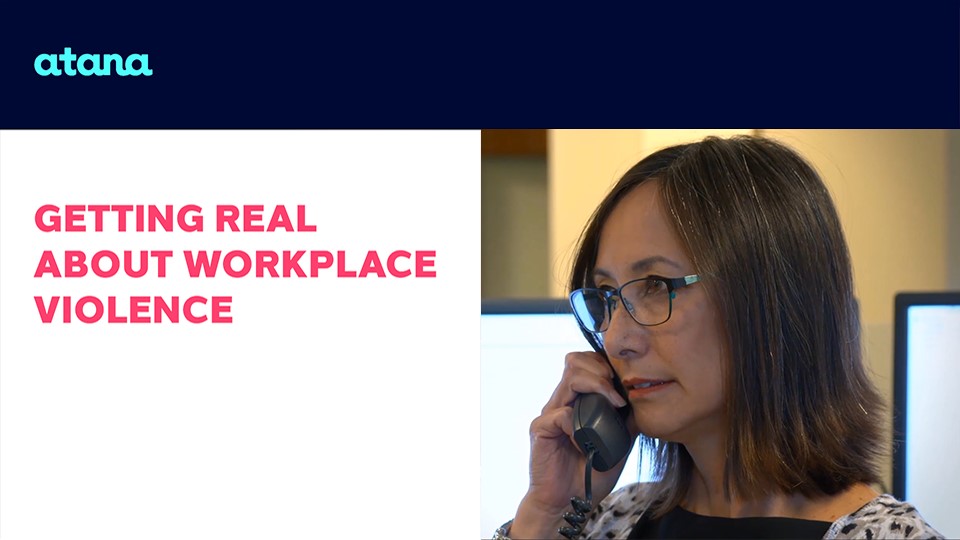
5 Essential Tips for Workplace Violence Prevention and Response
Workplace violence can be a tough topic—one that many of us would rather not think about. But the truth is, interpersonal violence doesn’t always start with physical harm. It can begin with intimidation, threats, or psychological distress, often building up over time. The good news? We all have the power to notice, speak up, and take action before situations escalate. In other words, to recognize, respond, and prevent.
This April, during Workplace Violence Awareness Month, we’re focusing on practical steps employees and leaders can take to create a safer work environment. Here are five essential tips on noticing change, speaking up early, responding to threats, cooling heated situations, and fostering a culture of safety.
Tip #1: SEE OR SENSE SOMETHING? Be aware and recognize change.
TWO SIMPLE QUESTIONS TO ASK:
- Am I noticing a CHANGE in a person or situation?
- Are they becoming more withdrawn, agitated, or fixated on grievances?
- Are interactions becoming increasingly tense, strained, or difficult?
- Am I UNSETTLED by someone's behavior or situation?
- Am I struggling to dismiss or explain away what I’m seeing/hearing?
- Does something feel off—even if I can’t put my finger on it?
- Trust your inner voice—intuition is often the first alarm.
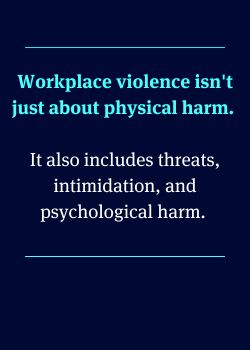

WHY IT MATTERS:
- Early awareness and action move us from being fearful about workplace violence to being mindful of prevention.
- Small changes in behavior can often signal bigger underlying issues.
- Prevention starts with noticing when something feels different.
Tip #2: SAY SOMETHING. Safety grows through action...speaking up early shows you care.
3 FEARS THAT HOLD US BACK (And How to Reframe Them)
- “I don’t want to get involved...” (Fear of personal risk)
- Empathy Reframes the Thought: If you’ve noticed something concerning, you’re already involved…but involvement doesn’t mean confrontation, it means caring enough to act.
- “I don’t want to be wrong…” (Fear of wrongly accusing someone)
- Empathy Reframes the Thought: It’s not about being right or wrong—it’s about checking in when something feels off.
- “I don’t want to make things worse.” (Fear of escalation)
- Empathy Reframes the Thought: Silence often allows things to escalate. The right words at the right time can make all the difference.
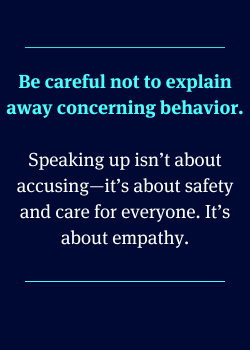

REPORT: Bringing a Concern Forward (Without Overreacting)
- Check-In: "Hey, I’ve noticed some changes. Are you okay?"
- Share What You've Observed: "I’m not making assumptions, but I’ve noticed < >, and I care. Do you want to talk about it?"
- Talk to Someone Who Can Help: A Manager, a Trusted Leader, HR or Security.
WHY IT MATTERS:
- Most workplace violence incidents don’t come out of nowhere—they build up over time.
- Many cases could be prevented if people voiced concerns earlier.
- Caring is courage. Silence can be costly. Speaking up can save lives.
Tip #3: RUN - HIDE - FIGHT. Prepare for the worst; know your options.
WHAT TO REMEMBER IN AN ACTIVE ASSAILANT SITUATION
- Your Best Option Depends on Where You Are and What’s Happening
- RUN. If escape is possible, GET OUT. Distance is safety.
- HIDE. If escape isn’t possible, GET SAFE. Find protection and concealment
- FIGHT. If directly confronted, GET TOUGH. Fight as though your life depends on it.
- Disbelief is Normal…ACTION IS ESSENTIAL
- In a crisis, you’ll probably experience disbelief. It’ll be vital to believe what you see and hear so you can PUSH THROUGH DISBELIEF into purposeful action.
- Quick mental check: What’s my nearest exit? Where would I go if I had to hide? What things could I use to fight?
- When First Responders Arrive
- Show your hands…don’t appear as a threat
- Follow instructions
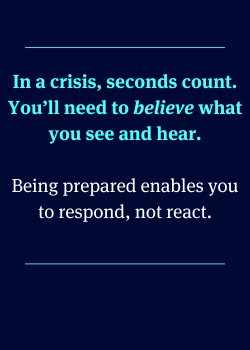

WHY IT MATTERS:
- People who think ahead react faster under stress.
- Training your brain ahead of time by running through scenarios can reduce panic in the moment and increase your optimism about survival…A survival mindset is key.
- A prepared workplace is a safer workplace.
Tip #4: EASY DOES IT…Turn down the heat through de-escalation.
6 KEYS TO DE-ESCALATION
- Stay Centered…Stay Regulated—Keep Your Thinking Brain in Charge
- BREATHE. Slow yourself and the situation down.
- Your response sets the tone. Stay calm, composed, and in control. Avoid taking things personally—their reaction isn’t about you.
- Listen to Understand – Not Respond
- Interrupting fuels frustration. Let the other person express themselves.
- Use active listening skills. Summarize, mirror, and ask clarifying questions.
- Be Gentle – Tone and Body Language Matter
- Tact and diplomacy go a long way.
- Stay mindful of your voice, posture, and facial expressions.
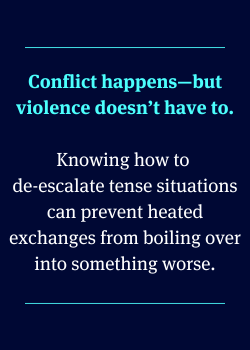

- Give Time and Space to Regain Control
- Don’t rush. People need psychological air to process emotions.
- Help their Thinking Brain catch up to their Survival Brain: "I can see this is frustrating. Take your time—we can work through this."
- Shift the Focus to Solutions
- Help shape expectations and bridge to a more constructive outcome. Ask "How do you think we can move forward from here?"
- Offer choices when possible—giving control reduces tension.
- Have a "Plan B" – Know When to Step Away
- Trust your intuition. If the situation escalates, step away. Say something like: "It sounds like this is important to you and it seems like you’re getting pretty frustrated. I’m going to step away for now to help cool things down."
- If needed, call a manager, HR, or security.
WHY IT MATTERS:
- Most workplace violence starts with verbal aggression. Handling it early can prevent escalation.
- Employees trained in de-escalation feel more confident and in control.
- A culture of calm response builds a safer, more respectful workplace.
Tip #5: BUILD TRUST…Nurture a culture of safety and security.
3 WAYS TO STRENGTHEN PSYCHOLOGICAL SAFETY AND ENGAGEMENT
- Nurture Belonging
- Employees who feel connected to their work and team are less likely to disengage in harmful ways.
- Encourage trust, not just compliance. When teams feel connected, empathy comes forward naturally, and people are more likely to look out for one another and voice concerns early.
- Ask: "What’s something small that could make this team feel more connected?"
- Reward Candor, Not Conformity (make it psychologically safe to speak up)
- On psychologically safe work teams:
- All individuals feel heard, valued, and trusted and can share thoughts and concerns without fear of judgment or retaliation.
- Team members assume good intent, foster trust, and empower others to contribute.
- Full and honest participation makes the team more mission-focused and innovative.
- A strong team culture allows for disagreement without fear. "We don’t have to agree, but we stay committed to listening."
- On psychologically safe work teams:
- Offer Support Over Disconnection
- Be willing to have courageous conversations. Issues left unaddressed can quietly erode trust and create long-term safety and security concerns.
- Remember that small moments of support go a long way. Instead of letting issues fester, create space for open conversations before tension builds.
- Use a simple phrase to get started: "Let’s talk this through now so we can move forward with clarity."
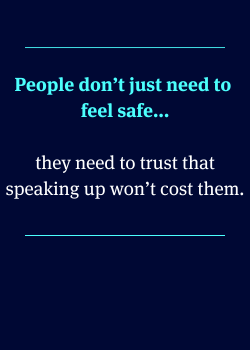

WHY IT MATTERS:
- Gallup research shows that employees who feel engaged, connected, and supported are more likely to step forward when concerns arise.
- The strongest workplaces are committed to having difficult conversations…they move through with both heart and courage.
- Psychological safety creates space for people to speak up—and trust they’ll be heard.

